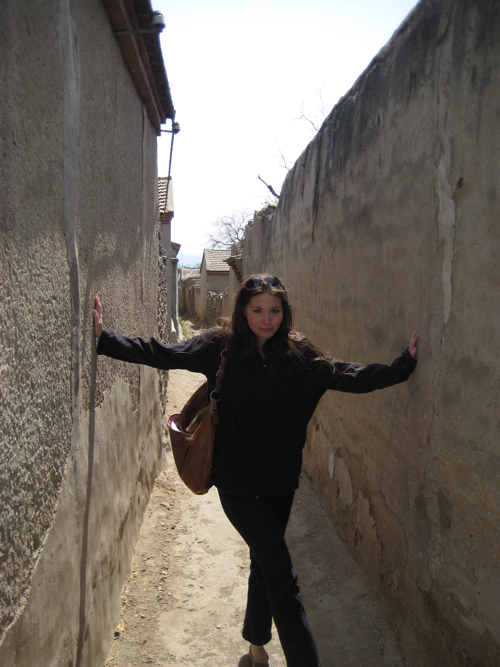We didn’t quite make it to Inner Mongolia, but after eighty miles out of Beijing it felt as though we got close (though in reality, we would have had to drive another four hours to reach that area). Instead, we returned to an old haunt, a place we had visited in 2003, and then again in 2004. Jimingyi Post Station, “one of the most famous postal stations in Chinese history”—built at the request of Genghis Khan, who desired a post road between Beijing and Xuanhua. The first two times we visited, it was a sleepy little town filled mostly with the elderly and small children (most everyone else having left to work in the large cities). I have so many photographs from those trips—and after today, I realize just how precious they’ve become.
Because everything has changed.
Okay, maybe not everything. But the essentials. When we were there before, we had unfettered access to remarkable wall paintings that could be found all over Jimingyi—in rotting temples, in an old school yard, in an ancient office. Beautiful works of art that were likely hundreds of years old, and preserved perfectly in the dry air. The locals were only too happy to guide us around (oh, I remember the barber shop where all the old men gathered to gossip…now gone, gone, gone), and explain the history; and no one minded how long we sat to stare, and talk, and just absorb how lovely, how remarkable, that such masterpieces could exist in this town that had played such an important historical role—one that almost everyone had forgotten. Most especially pleasant was speaking with Mr. Liu, a gentleman in his eighties who knew a great deal about the paintings, and had been featured in an article or two (which he liked to show, with a twinkle in his eye). He was such a sweet man.
Well, I learned today that he died several years ago. And beginning in 2007, the city was remade. The temples redone and the paintings locked up, accessible only with a key. In fact, only one of the wall paintings was available for viewing. Not even the best one, in my opinion. The most lovely of the paintings, truly exquisite works of art, were no longer accessible. In fact, the doors have been walled up with brick, which I found a bit disturbing. We were assured that the paintings are still there (just closed for renovation), but no one really wanted to speak of them, and we had to dig for answers. I’m concerned that they’re not there anymore—stolen or defaced—and that no one wants to admit to it. But maybe I’m being paranoid.
Of course, when it comes to historical preservation and China, it pays to be uneasy.
Either way, you can’t see those paintings anymore. You just can’t. At least not for a while (hopefully it really is just renovations going on…good renovations, at least). And to pass into the town itself now requires buying tickets (and in our case, being hounded by several people who demanded to know ‘where the Americans were’ so they could make sure we still had our passes). The locals I saw no longer looked so cheerful—just jaded, disgruntled—which was understandable given the massive numbers of tourists that were there . Seriously. Tour groups everywhere, led by young women with big microphones; and dudes with giant cameras scampering over the walls, acting like macho men with a lens. At one point I almost felt as though I was lost in one of those pretend villages that you see in an amusement park—you know, Merry Medieval Land, where everyone dresses up to reenact history for the folks with the cameras. Except no one in Jimingyi was dressing up—just going about their business. But they were still on display. Still ogled by outsiders (including us, I suppose), who were led to areas in the village that were, in my opinion, utterly insignificant: the interior of a sample house (so you could see how locals live), the courtyard of a former postal office, the school that was now being represented as a temple—and yes, one of the real temples, though it had been reconstructed so that its raw rambling beauty was totally gone.
I was disappointed. And yet, when I read this article on Adam Minter’s twitter, about a 1000 year old temple being bulldozed to make way for a luxury bathhouse, can I really complain that Jimingyi has turned into a tourist trap? Isn’t tourism better than being forgotten or destroyed? I have to say yes. But I am deeply sorry that the spirit of the place is so different now.
Anyway, here on some pictures. I don’t have my 2003/2004 shots on the laptop to show the contrast. And don’t get me wrong, it’s still a lovely place. It’s just that the history that was supposed to have been preserved has been turned into something bland and not entirely representative—and no one who visits now, for the first time, will likely ever know the difference. And that’s just…sad.
PS: Taughnee designed me a wonderful travel blog that I’ve been loading old China entries onto—you can catch a glimpse of one of those (now hidden) paintings in the header graphic.


I remember this painting from before, but again—while pretty—not the most exquisite that Jimingyi has to offer.

The statue was here before, but protected only by the barest of structures, with a torn lavender curtain hanging in front of him that was constantly moving in the wind.

One of the main gates, which has been heavily renovated. I remember most of the wall being made mostly of old brick and mud, but this is much more polished. If you look at the next picture (below) you’ll see what I found in 2004: a rough segment of the original wall.


